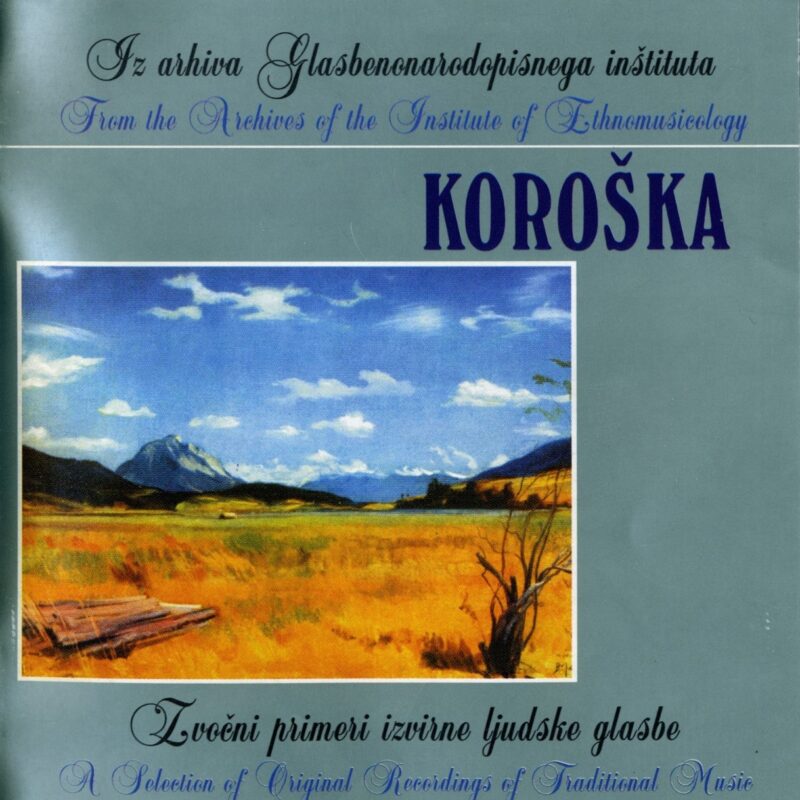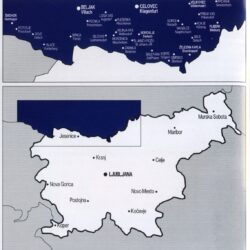Koroška: A Selection of Original Recordings of Traditional Music

GNI M 35.743
Recorded: Potoče, Zilj. dol., 5. 2. 1976
Sung by: Jožef Jarnik, pd. Ringar, 1910; Rohan Rogi, vulgo Grevž, 1920; Johan Kuri, pd. Belan, 1920; Peter Hebein, vulgo Jamerč, 1911.
GNI M 36.700, 713, 710, 709
Recorded: Dole, Zilj. dol., 24. 9. 1976
Recited by: Franc Wutti, vulgo Vinklar, 1928
GNI M 37.630, 631
Recorded: Blače, 3. 7. 1977
Performed by: A group of locals
GNI M 37.301, 296, 297, 298, 302, 303, 307, 308, 309
Recorded: Pečnica, 24. 3. 1977
Recited by: Ljudmila Štiker, 1914
GNI M 37.309 Sung by Peter Štiker, 1940
GNI M 38.470
Recorded: Loga vas, 6. 1. 1979
Sung by: Tevži Kakl, vulgo pər Mlinari, 1916, two unknown singers
GNI M 35.741
Recorded: Potoče/Zilj. dol., 5. 2. 1976
Sung by: vulgo Jožef Belan, Jarnik, 1920; vulgo Peter Ringar, Hebein, 1910; vulgo Johan Jamerč, Rogi, vulgo 1911. Grevž, 1920; Johan Kuri, vulgo Belan, 1920; Peter Hebein, vulgo Jamerč, 1911.
GNI M 37.882
Recorded: Brnca, 26. 12. 1977
Performed by: Jurij Mikič (Georg Miggitsche), vulgo Irgič, 1925
GNI M 38.476
Recorded: Bilčovs, 6. 1. 1979
Sung by: Geli Ogris-Martit, 1960; Mili Gaser, 1961.
GNI M 38.366, 368, 374, 375
Recorded: Plešerka, 23. 11. 1978
Recited by: Mihael Mothe, vulgo Motei, 1912.
GNI M 38.987
Recorded: Bilčovs, 2. 12. 1979
Sung by: A group of men and boys
GNI M 38.530/B
Recorded: Šentjanž v Rožu, 8. 1. 1979
Sung by: Jozi Turk, 1911; Aloiz Ogris, 1931; Mihael Pečnik, vulgo pri Toniju, 1917; Uršula Pečnik, 1924; Marija Pšajdar, 1925.
GNI M 38.391
Recorded: Velinja vas, 24. 11.1978
Sung by: Franc Krušič, vulgo Rupi, 1892.
GNI M 37.960
Recorded: Moščenica, 27. 12. 1977
Sung by: Šimon Kröpfl, 1907
GNI M 38.537
Recorded: Šentjanž v Rožu, 8. 1. 1979
Sung by: Jozi Turk, 1911; Alojz Ogris, 1931; Mihael Pečnik, vulgo pri Toniju, 1917; Uršula Pečnik, 1924; Marija Pšajdar, 1925.
GNI M 38.475/2
Recorded: Bilčovs, 6. 1. 1979
Sung by: Geli Ogris-Martič, 1960; Mili Gaser, 1961
GNI M 39.023
Recorded: Selje, 5.12.1979
Sung by: A group of singers led by Jozi Starc, 1939.
GNI M 39.969
Recorded: Sele pri Fari, 1969
Sung by: Franc Pristovnik, Pepi Oraže, Hanzej Roblek, Lojze Kelih, Florijan Kelih
GNI M 38.872
Recorded: Žabnica, 3. 12. 1979
Performed by: Pavel Lausseger, 1911.
GNI M 39.193
Recorded: Korte, 6.12.1979
Sung by: Franc Smrtnik, 1933;
Stefan Pavlič, 1934: Eleonora Pavlič, 1936, Marija Smrtnik, nee. Ogris, 1940;
Katarina Smrtnik, 1929; Milica Smrtnik, 1921
GNI M 39.146/B
Recorded: Obirsko. 8. 12. 1979
Sung by: Johan Brumnik, vulgo Hanza Hribernik, 1919; Folti Karničar, vulgo Narkov Folt, 1930; Liza Karničar, vulgo Artačeva, 1933; Marta Polanšek, 1953; Justi Polanšek, 1926; Valentin Polanšek, 1926; Marija Brumnik, vulgo Kristlova Mici, 1929; Pepi Brumnik, vulgo Štrublov Pepi, 1949
GNI M 39.079
Recorded: Kokje, 7. 12. 1979
Sung by: Zofka Šajternig, vulgo pər Plešovniku, 1937
GNI M 39.145
Recorded: Obirsko, 8. 12. 1979
Sung by: Johan Brumnik, vulgo Hanza Hribernik, 1919; Folti Karničar, vulgo Narkov Folt, 1930; Liza Karničar, vulgo Artačeva, 1933; Marta Polanšek, 1953; Justi Polanšek, 1926; Valentin Polanšek, 1926; Marija Brumnik, vulgo Kristlova Mici, 1929; Pepi Brumnik, vulgo Štrublov Pepi, 1949
GNI M 31.853
Recorded: Zgornje Krčanje, 2. 3. 1969
Sung by: Pavla Hafner, nee. Lutnik, 1939; Rozina Konetschnig, pd. Keš, 1937; Marija Rapatz, 1921; Mihael Rapatz, vulgo Bukovnik, 1921; Johan Grilc, vulgo Zupanc, 1936; Krištof Zupanc, vulgo Nore, 1926; Franc Hafner, vulgo Kočmar, 1930; Jožef Hauser, vulgo Rojak, 1917; Alojz Rapatz, vulgo Ribejžel, 1929.
GNI M 39.073
Recorded: Kokje, 7. 12. 1979
Sung by: Zofka Šajternig, vulgo pər Plešovniku, 1937.
GNI M 39.088
Recorded: Nagelče, 7. 12. 1979
Performed by: Silvester Mohar, vulgo Kogelnik, 1916.
GNI M 39.131
Recorded: Pribija vas, 8. 12. 1979
Sung by: Micka Kert, vulgo pər Žnidarji, 1910; Zofka Šajternig, vulgo pər Plešovniku, 1937
GNI M 31.895
Recorded: Zgornje Krčanje, 6. 4. 1969
Sung by: Alojz Rapatz, vulgo Ribejžel, 1929.
GNI M 39.134
Recorded: Priblja vas, 8. 12. 1979
Sung by: Micka Kert, vulgo pər Žnidarji, 1910; Zofka Šajternig, vulgo pər Plešovniku, 1937
GNI M 39.120
Recorded: Gorce/Št. Vid, 7. 12. 1979
Sung by: Hanzi Kežar, vulgo pri Lekšu, 1928; Nani Kežar, 1935; Marija Kežar, 1963; Anica Kežar, 1954; Danica Kežar, 1956; Milan Kežar, 1958; Marko Marko, vulgo pər Markovih, 1936; Fani Marko, 1943; Stanko Polzer, 1962.
The Koroška audio publication is an edited selection from two records released together on the Maribor-based Obzorja label in 1983. Examples of original folk music were recorded tor the two discs by fellows of the Institute of Ethnomusicology (Dr. Valens Vodušek, Dr. Zmaga Kumer, Mirko Ramovš, Dr. Marko Terseglav and Julijan Strajnar) in the period from 1976 to 1980. The accompanying text for the audio publication is an extract from the one written in 1983 by the compiler. It was edited by Drago Kunej.
The audio publication contains 29 samples from the original release: love songs (Nos. 1, 5, 8, 10, 11, 14, 20 and 24), narratives (Nos. 12, 15 and 23), children’s songs and nursery rhymes (Nos. 2, 4 and 9), carols (Nos. 16, 26 and 28), wedding songs (Nos. 6 and 19), a ceremonial dance (No. 3), a guild song (No. 22), a name day song (No. 29), a death lament (No. 21 ), a patriotic piece (No. 18), a study song (no. 13), a devotion (No. 17), a New Year celebratory piece (No. 27), and two instrumenta! dance melodies (Nos. 7 and 25).
The song lyrics are given in a simplified phonetic transcription (by Dr. Zmaga Kumer), while the music was transcribed by Julijan Strajnar (except Nos. 21 to 29, which were transcribed by Igor Cvetko). The monophonic pieces have been transposed so that the final note is G’, while at the end of the melody the original pitch is shown by a note with no tail. The polyphonic and instrumental pieces are shown in their original pitch. The metronomic mark J,= 86-110 signifies an accelerando. The time signature is shown as (5/4), while ) at the beginning of a line denotes a preliminary bar which only appears in some verses. + 1/4 shows the value by which the basic bar is extended. J, ), denotes a ligature, which only occur in certain verses, and a dotted bar line (!) shows the principal accent or a secondary accent in composed bar measures.
Notes with tails in opposite directions (Jr) mark the rhythmic changes that occur in some verses, while v and r-. indicate the shortening or lengthening of a note by less than half of its value. * denotes an unpitched note. The place and date of recording are shown at the top of every score, along with the piece’s serial number in the sound archives (M 31.853). At the bottom of the score the name, pseudonym and year of birth of the singer or musician are shown. After the lyrics a glossary of lesser-known dialect terms is printed as required.
The Slovenians settled Carinthia in the 6th century, at the same tirne as the other regions; in the 7th century their ethnic territory achieved its maximum expansion. But as early as the 8th century the Slovenian principality of Carantania lost its independence, and fell under Bavarian and Frankish dominion. Towards the end of the Middle Ages, partly because of foreign colonization and partly because of pressure, the northern frontiers of the ethnic territory began shifting south; thus, the current area of Slovenian Carinthia is only a tenth of what it used to be. It in the Middle Ages, Carantania was synonymous with Slovenia, and Slovenians on either side of the Karavanken range were called Carantanians. As late as the 19th century, Carinthia contributed as much to the development of Slovenian culture, as the central regions of Slovenia, and Celovec (Klagenfurt) in some respects outshone even Ljubljana. Neither at the end of World War 1, nor at the end of World War II were Carinthian Slovenians able to join their co-nationals in a single national state. They were destined to remain a minority, exposed to political, cultural and economic pressure. Nevertheless, Slovenian Carinthia is, from the viewpoint of ethnology, an integral part of the Slovenian ethnic territory, and popular traditions ony help to confirm this view.
Slovenian Carinthia is composed of a »garland of three valleys«, Rož, Podjuna, and Zilja, which at the same tirne represent three distinct dialects. They differ considerably one from another, and their archaic traits set them apart also from the bulk of Slovenian dialects.
In linguistic and folklore terms Slovenian Carinthia is part of the ethnically Slovene lands. The Carintian Slovenes are enthusiastic singers; they cultivate, with particular predilection and choral singing, for even folk songs are polyphonic in Carinthia. The repertoire of the choirs consists mostly of adaptations of folk songs from Carinthia and other Slovenian regions. Instrumental music is less significant: it only serves to accompany dances, and the muscians are nowadays predominantly accordion players (mehač, or mehovec, in the Carinthian dialects).
The dances are the same as in the rest of Central Europe. A unique feature is the prvi rej of Zilja Valley, which formally resembles Styrian dance (štajeriš) with song accompaniment, but differs from it both in rhythm and by its character of strictly ritual dance, held only once a year, after the štehvanje competition. Before the appearance of the accordion, the Carinthians used the same folk instruments as other Slovenian regions. The sources mention, for instance, fiddles and oprekelj. There is also a number of toy instruments and shepherds pipes with various names in the local dialects.
In content, the Carinthian folk songs are by no means a special development. They are closely linked with the general Slovenian musical traditions, though some songs are typical in the region. Since the Karavanken range was never an impassable barrier, the songs were transported from Carinthia to other Slovenian regions, and vice versa. There are remarkably few narrative poems in Carinthia, even less than elsewhere in Slovenia. Apparently after the 18th century short four-line songs in the jumpy »Alpine rhythm« prevailed; they derive from improvised mocking rhymes sung at the štajeriš dance. While in other Slovenian regions such rhymes encouraged the development of various strophic forms with a greater number of lines, Carinthia has preserved the original four-line verse, sung in slow measure, often to specially-developed tunes. If the four-part or five-part singing of Carinthia was at one time considered a regional trait, recent research indicates that it is only an ancient style of polyphonic singing once prevailing throughout the Slovenian territory. It was linked to songs of a wide tonal range and harmonic structure, which, according to experts belonged to an archaic layer of folk tradition. The dialect expressions defining the various voice parts, and describing the polyphonic style of singing point to its development independent of the choral tradition. In the Zilja Valley, for instance, some songs are sung »up-and-down« (vis-pa-dov) one singer begins the song, and carries (vozi) the tune, a second embroiders the tune by moving at a higher or a lower pitch, a third may join him as the »third part« (na trečo), while all the remaining singers take the bass part. The locals say the song must wind its course like the Zilja River. Carinthian singing produces a full, harmonious and soft sound.
Warmest thanks go to all those who assisted in any way with the preparation of this audio publication. I am particularly grateful to my colleagues Zmaga Kumer and Drago Kunej, and to Vilko Ovsenik, who came up with the idea for the audio publication. Naturally, my deepest gratitude goes to all the singers and musicians on the pieces; they are testimony to the persistence of our fellow Slovenes on the other side of the Karawanken Alps. Let us hope that this audio publication encourages them to preserve their national character.
Julijan Strajnar, Ljubljana 1998
Translation AMIDAS d.o.o.

